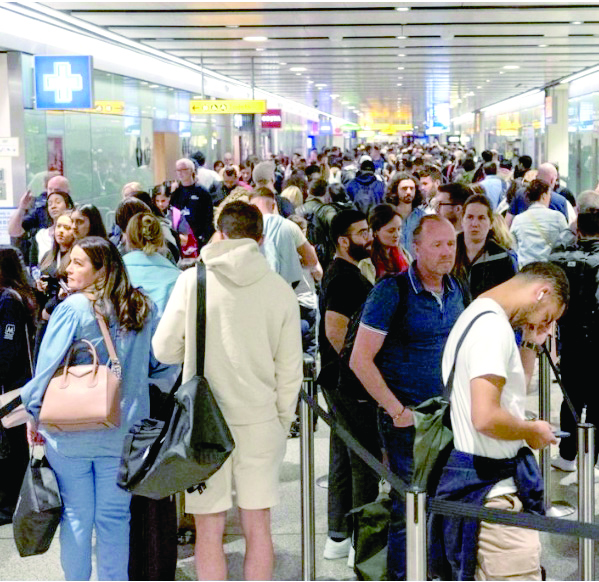World travel back on calenders after coronavirus break

The number of goodbyes — and welcomes — witnessed in international airports has welled like tears in anxious eyes since the world turned its back on the Covid-19 period that disrupted international travel.
World Travel Organisation (UNWTO) data shows that international tourism is well on its way to returning to pre-pandemic levels with over 960 million tourists travelling across borders last year alone. Of these, about 235 million travelled in the first three months, more than double the same period compared to 2022.
Overall, international arrivals reached 80 per cent of pre-pandemic levels in the first quarter of 2022. As a result, international tourism receipts grew to hit the $1 trillion mark in 2022, growing 50 per cent in real terms compared to 2021.
Tourist arrivals
The annual Tourism Sector Performance Report of 2022 indicates that Kenya’s total international tourist arrivals grew by 70.45 per cent to 1.48 million in 2022, from 870,465 in 2021.
Earnings grew by 83 percent to Sh268.09 billion ($2.1 billion), from Sh146.51 billion ($1.15 billion) in the same period in 2021.
UNWTO Secretary-General Zurab Pololikashvili said: “The start of the year has shown again tourism’s unique ability to bounce back. In many places, we are close to or even above pre-pandemic levels of arrivals.”
“However, we must remain alert to challenges ranging from geopolitical insecurity, staffing shortages, and the potential impact of the cost-of-living crisis on tourism, and we must ensure tourism’s return delivers on its responsibilities as a solution to the climate emergency and as a driver of inclusive development.”
He attributed in a statement the speedy recovery to World Health Organization to lift travel restrictions in post Covid-19 period. Travel restrictions peaked in May 2020 when 75 percent of all destinations worldwide had their borders completely closed, bringing international tourism almost to a standstill.
With the better understanding on the virus, a more risk-based approach became possible and allowed destinations to replace complete border closure with softer measures, such as testing and vaccination requirements for tourists.
UNWTO Secretary-General Zurab Pololikashvili says: “The safe easing or lifting of restrictions on travel are essential for the restart of tourism and the return of the social and economic benefits the sector offers.
At the peak of the pandemic he had opposed to the blanket travel restrictions.
“In fact, by cutting the lifeline of tourism, these restrictions do more harm than good, especially in destinations reliant on international tourists for jobs, economic wellbeing and sustainable change,” said the SG.
Tourism was one of the most affected sectors worldwide.
The UNWTO during the outbreak emphasized the need to ‘putting people and their wellbeing first’ through the slogan; ‘By staying home today, we can travel tomorrow’. The WHO declared Covid-19 a pandemic on 11th March 2020. Since then, the Covid-19 virus spread to over 200 countries globally
Impact of Covid-19 on Tourism in Kenya research was done in June 2020 by the national steering committee under the ministry of tourism and that shade insight into the crisis tourism was experiencing:
Hotels: Although the pandemic came during the low tourist season in Kenya, the hotel sector has experienced an abrupt and unprecedented drop in hotel demand that has led to closure of most hotels. Consequently, some hotels have consequently sent some staff on paid and unpaid leaves.
An escalation in the crisis could see passenger volumes fall by 1.6 million and $320 million in lost revenues.
MICE contributed 13.5 percent of the total 2,048,834 international arrivals in 2019 in Kenya, where at least 276,592 visitors participated in meetings and business. The sub-sector remains key in Kenya tourism receipts which in 2019 grew by 3.9% to Sh163.56 billion, which is threatened by Covid-19 pandemic.
Pre-pandemic levels
By regions, Europe enjoyed the best results in 2022 with nearly USD 550 billion in tourism receipts (EUR 520 billion), or 87 percent of pre-pandemic levels. Africa recovered 75% of its pre-pandemic receipts, the Middle East 70 percent and the Americas 68 percent. Due to prolonged border shutdowns, Asian destinations earned about 28 percent.
The Middle East saw the strongest performance as the only region exceeding 2019 arrivals (+15%) and the first to recover pre-pandemic numbers in a full quarter.
Europe reached 90 percent of pre-pandemic levels, driven by strong intra-regional demand.
Africa reached 88 percent and the Americas about 85 percent of 2019 levels. Asia and the Pacific accelerated its recovery with 54 percent of pre-pandemic levels, but this upward trend is set to accelerate now that most destinations, particularly China, have re-opened.
In many places, we are close to or even above pre-pandemic levels of arrivals.









